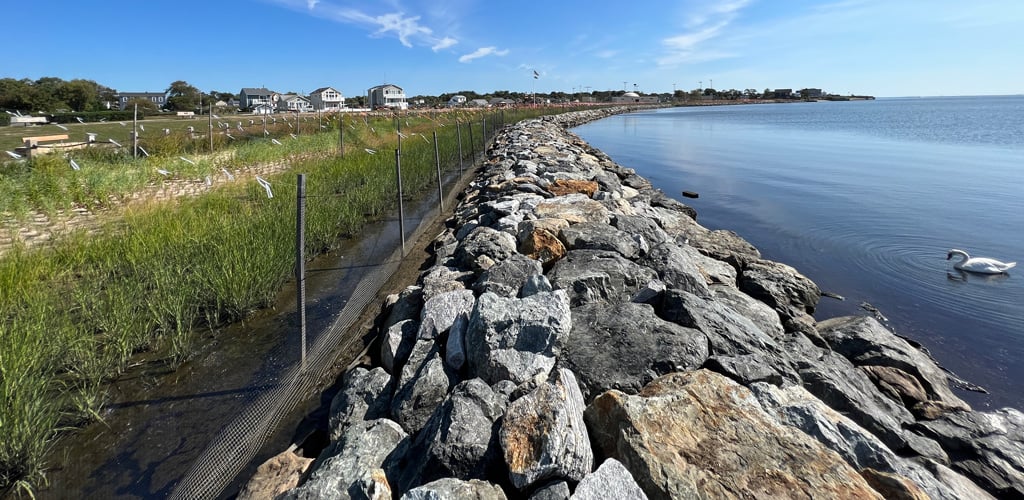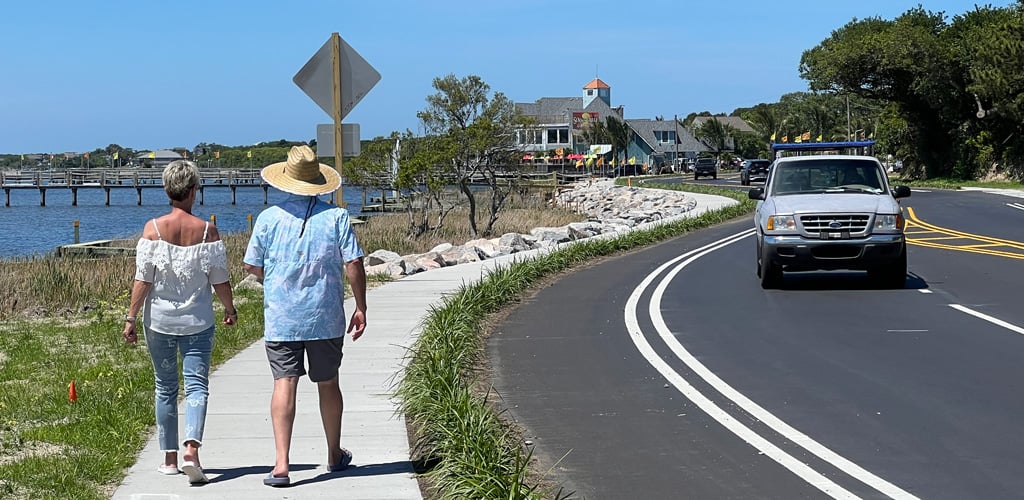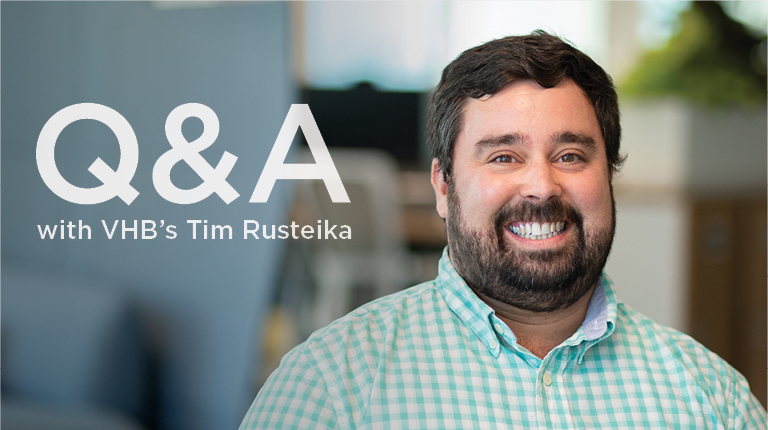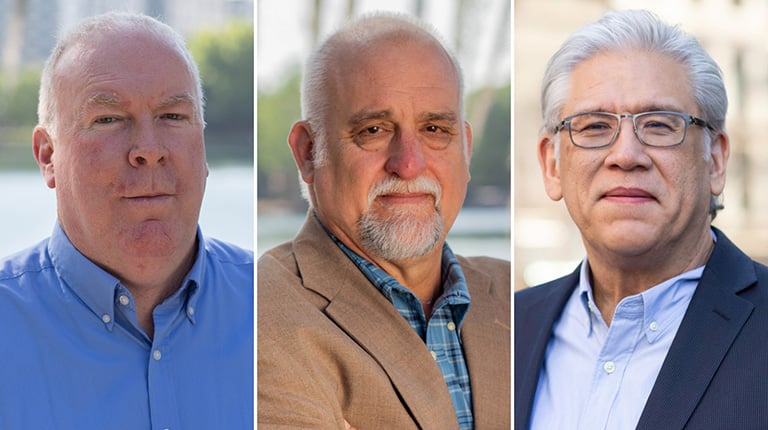
Bryce Corlett’s 16 years of diverse experience in the coastal environment ranges from identifying sea level rise acceleration along the East Coast, to guiding local, state, and national organizations through climate adaptation, to beach and shoreline restoration. He joined VHB last year as Senior Coastal Engineer to help deliver resilient and adaptive solutions to waterfront redevelopment and development challenges in response to climate change. Since joining, he has embraced opportunities to lead and innovate, serving as Chair of VHB’s Mid-Atlantic Innovation Ambassadors team and continuing to contribute to the American Society of Civil Engineers (ASCE) Coasts, Oceans, Ports & Rivers Institute (COPRI) Piers and Wharves Design Standards Subcommittee. We spoke with Bryce to find out more about the challenges and opportunities facing coastal communities, his technical work through COPRI, and key takeaways from the recent COPRI Ports ‘25 conference.
VHB: What are the biggest challenges and opportunities facing coastal communities right now?
Bryce: VHB works within coastal communities across the East Coast, from Southeast Florida to the coasts of Virginia, up through Long Island and along New England’s coastline. Each faces ongoing challenges, including effects from extreme weather events and sea level change. Challenges may look a little different depending on the region, but at the end of the day, these communities are all grappling with how to live with rising waters and how to deal with aging infrastructure. Coastal infrastructure was designed, in some cases, 50 years ago or more, and was based on the best available science at the time. Changing conditions dictate a need for changing designs to best plan for the future.
I like to look at these challenges as opportunities. We have the opportunity to move forward in a new way and rethink our design approach so that our coastal communities can thrive. How can we incorporate water and a moving, natural shoreline into the fabric of a community? At VHB, we take a well-rounded approach to coastal engineering and resiliency to create solutions that work in harmony with both the natural and built environments.
VHB: You mentioned that coastal communities are dealing with aging infrastructure. What types of infrastructure are we talking about?
Bryce: Infrastructure is such a broad term. Historically, coastal infrastructure meant rock, steel, wood, and vinyl—bridges, rock revetments, sea walls, piers, wharves, and even nearby buildings and roadways. Today, the term coastal infrastructure has expanded to include natural infrastructure like planted shorelines, mangrove forests, living shorelines, parklands, and fields. What’s unique about VHB is how we approach these projects, bringing together a wide range of services whether it’s surveying the shoreline, planning resilient waterfronts, designing transportation systems, or helping communities prepare for the impacts of flooding.

VHB: You are part of the ASCE COPRI Piers and Wharves Design Standards Subcommittee. Tell us how you first got involved with this organization and about the work that you’re doing now.
Bryce: I’ve been a member of ASCE since college—I was involved with my local chapter as an undergrad—and I joined the Piers and Wharves Design Standard Subcommittee roughly two years ago. The group is comprised of approximately 50 members, with a wide variety of backgrounds. We have members from Naval Facilities Engineering Systems Command (NAVFAC), U.S. ports, academia, and consulting firms.
There are few existing design standards for port and harbor infrastructure. Our group is developing a design standard specifically for piers and wharves. I sit on the chapter that’s drafting guidance for developing site conditions, or how to develop an understanding of the wind/wave/water level conditions at the site as well as how to calculate wind/wave/water level loads for structural design. Eventually, these standards will get rolled into national, state, and municipal codes. It’s been very rewarding to be part of a working group, collaborating with and learning from like-minded engineers trying to develop standards for a field that continues to evolve. That’s also why I stepped into the role of Chair for VHB’s Mid-Atlantic Innovation Ambassadors group—I wanted to be a part of the idea-sharing and collaboration, especially as technology, artificial intelligence, and innovation continue to push our industry in new directions.
VHB: Speaking of working with like-minded professionals, you recently attended ASCE COPRI’s Ports ‘25 conference. What key takeaways can you share?
Bryce: The Ports event is held every other year, with international attendees including ports, harbor, waterway, and marine professionals. Papers and presentations covered a wide range of topics from vessel mooring and berthing to automated terminals. My key takeaways include:
- Practitioners and ports are pushing for more detailed understanding of how to best incorporate new construction with aging waterfront infrastructure. This is taking the form of modeling degradation rates for timber piles, concrete decking, and bulkheads.
- BIM is being woven into site planning through innovative combinations of topo bathymetric lidar, geotechnical surveys, and preliminary design for port complexes.
- Francisco Lefler from PIANC (World Association for Waterborne Transport Infrastructure) said it best when describing where the field is moving: “Resilience means knowing the design conditions, but also knowing how infrastructure will react outside of the design conditions and being able to provide guidance.” We know that bigger events are always possible, and it’s our job as engineers to provide designs that transparently incorporate uncertainty.
VHB: What do you see on the horizon for coastal engineering and resiliency at VHB?
Bryce: Coastal engineering is evolving to take a more holistic approach. We’re seeing projects marry coastal engineering with landscape architecture or community planning. For example, the Middle Peninsula Planning District Commission’s (MPPDC) Multimodal Working Waterfronts project used surveys, social media, and in-person meetings to capture stakeholder input. Feedback from local watermen, buyers, and distributors was integral in shaping the direction of the project, which aims to enhance waterfront infrastructure and amenities across 11 publicly owned working waterfront locations, supporting the commercial seafood and maritime industries that play a vital role in the local economy while also benefiting the wider community. Similarly, our work for the Town of Duck, North Carolina, and Pungo Ferry Road in Virginia Beach feature coastal and transportation engineering working together to enhance communities.

VHB continues to grow by recently joining forces with Waterway Surveys & Engineering and Harbor Engineering, two coastal engineering firms focused on helping clients protect and improve their assets along tidal waterways and waterfronts. These acquisitions bring additional capacity, expanded capabilities, and exciting new project work. We now offer in-house services ranging from dredge design; bulkhead, pier, and wharf design; marina design; and hydrographic survey. These expanded survey capabilities provide high precision data that supports more efficient design and construction, and better-informed decision making for complex waterfront infrastructure projects.
Coastal engineering at its best happens when different capabilities and experience work together to deliver locally sensitive, transformative solutions for coastal communities.
Learn more about coastal engineering and resiliency at VHB or connect with Bryce via email or LinkedIn.


